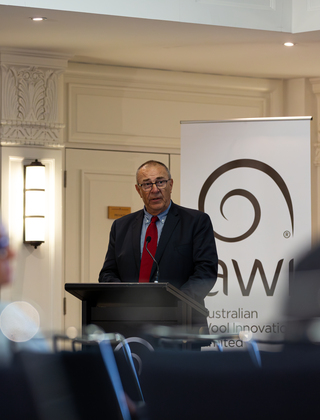Australian Wool Production Forecast Report April 2018
The Australian Wool Production Forecasting Committee forecasts that Australian shorn wool production in 2017/18 will reach 338 mkg greasy. This is a 0.6% decline from the levels in 2016/17 and is largely the result of more difficult seasonal conditions in many of the major wool growing areas. This has resulted in lower fleece weights. It comes despite the strong wool market conditions which are encouraging producers to retain sheep. The Committee’s first forecast for 2018/19 is for shorn wool production to be 333 mkg greasy, a further fall of 1.7%, due to a combination of slightly lower wool cuts per head and lower number of sheep shorn. This early forecast assumes normal seasonal conditions in 2018/19.
- The Australian Wool Production Forecasting Committee forecasts that Australian shorn wool production in 2017/18 will reach 338 mkg greasy. This is a 0.6% decline from the levels in 2016/17 and is largely the result of more difficult seasonal conditions in many of the major wool growing areas. This has resulted in lower fleece weights. It comes despite the strong wool market conditions which are encouraging producers to retain sheep.
- The Committee’s first forecast for 2018/19 is for shorn wool production to be 333 mkg greasy, a further fall of 1.7%, due to a combination of slightly lower wool cuts per head and lower number of sheep shorn. This early forecast assumes normal seasonal conditions in 2018/19.
The Australian Wool Production Forecasting Committee (AWPFC) has revised its forecast of shorn wool production for the 2017/18 season to 338 million kilograms greasy, a 0.6% decline on the 2016/17 season and lower than its forecast at its December 2017 meeting.
Committee Chairman, Russell Pattinson said that "seasonal conditions in the major sheep producing areas across Australia have been very dry through Summer and the first part of Autumn, which has resulted in lower than expected fleece weights. While Tasmania and Western Victoria have experienced good seasonal conditions, some of the major sheep producing regions in New South Wales, eastern Victoria, South Australia, Western Australia and Queensland have been very dry. Wool production reductions are greatest in WA (-7.3%), Queensland and NSW while Victoria showed the largest increase (+ 5.7%) with slight increases in SA and Tasmania.
"While the Committee expected that fleece weights would pull back as the season progressed, the decline has been more than anticipated. This is reflected in the drop in wool tests by AWTA in February and March.
"Furthermore, the high wool prices encouraged producers to shear their sheep earlier and the volume of prem shorn wool has increased. This has contributed to the recent decline in wool test volumes as wool which normally would have been delivered in recent months was delivered earlier in the season.
"The weight of wool tested by AWTA in the nine months of 2017/18 is now on par with the level in 2016/17, after being 5% higher to November. The Committee expected that wool volumes would slow in the second half of the season, but this slowdown has been more than anticipated. The Committee expects this to continue in the remaining three months of the season."
The AWPFC’s first forecast of shorn wool production for the coming 2018/19 season is for production to be 333 mkg greasy, a 1.7% decline on the 2017/18 forecast. This fall reflects the impact of the dry seasonal conditions recently and is the result of a small fall in both the number of sheep shorn and in average wool cuts per head.
The Committee noted that for the 2017/18 season to March, the AWTA test data showed a significant decline in the weight of wool tested of 16.5 microns and finer, as well as a decline in the volume of 20 to 26 micron wool. Volumes have increased for other micron ranges. The average mean fibre diameter for the season to March was 21.1 micron, up by 0.1 micron. Victoria, Tasmania and New South Wales all recorded a lift in mean fibre diameter for the season, while Western Australia has seen a fall of 0.6 micron. The mean fibre diameter was steady in Queensland and South Australia. The average staple length across Australia has fallen by 1.8mm to 87mm, with all states recording shorter average staple length for the season to date.
| Table 1: Summary of wool production estimates and forecasts for Australia | |||||
| Parameter | 2016/17 Final Estimate |
2017/18 Final Estimate |
Change y-o-y (%) | 2018/19 Third Forecast |
Change y-o-y (%) |
| Sheep numbers shorn (million head) |
74.3 | 76.0 | +2.3% | 75 | -1.3% |
| Average cut per head (kg/head) |
4.58 | 4.45 | -2.8% | 4.43 | -0.4% |
| Shorn wool production (mkg greasy) |
340 | 338 | +0.6% | 333 | -1.7% |
| Note: Totals may not add due to rounding | |||||
| Table 2: Total shorn wool production by State - 2016/17, 2017/18 and 2018/19 | |||||||
| mkg greasy | NSW | VIC | WA | SA | TAS | QLD | National |
| 2016/17 Final Estimate (mkg) | 122.9 | 66.1 | 65.2 | 54.8 | 9.1 | 6.9 | 340 |
| 2017/18 Final Estimate (mkg) | 126.0 | 67.4 | 71.1 | 57.9 | 9.2 | 8.5 | 341 |
| Change y-o-y % | -2.6% | +2.7% | +9.1% | +5.6% | +1.5% | +23.0% | +0.3% |
| 2018/19 Third Forecast(mkg) | 125.1 | 71.2 | 65.9 | 58.5 | 9.3 | 8.3 | 338 |
| Change y-o-y % | -0.8% | +5.7% | -7.3% | +1.0% | +1.4% | -2.6% | -0.6% |
| Note: Totals may not add due to rounding | |||||||
The National Committee drew on advice from the six State Committees, each of which includes growers, brokers, private treaty merchants, representatives from State Departments of Agriculture, and the Australian Wool Testing Authority. Data and input was also drawn from AWTA, AWEX, wool exporters, the Australian Bureau of Statistics, ABARES, and Meat and Livestock Australia.















